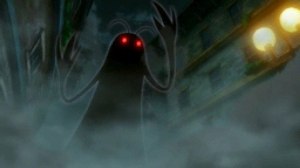 Just in time for the fifth game in the series, and nearly one year after its initial release, Professor Layton’s first adventure, and last on the DS, has once again proved to me that puzzle games and English accents should always go hand-in-hand. Professor Layton and the Last Specter is the first in a prequel trilogy detailing the eponymous archeologist’s first meeting of series favorite Luke, as well as newcomer Emmy and another adventure full of mystery, puzzles, and tons of diversions to keep you entertained after the curtain has closed. Though I didn’t find it as entertaining as previous romps, The Last Specter is a solid title that is one of the best puzzle games on the aging system.
Just in time for the fifth game in the series, and nearly one year after its initial release, Professor Layton’s first adventure, and last on the DS, has once again proved to me that puzzle games and English accents should always go hand-in-hand. Professor Layton and the Last Specter is the first in a prequel trilogy detailing the eponymous archeologist’s first meeting of series favorite Luke, as well as newcomer Emmy and another adventure full of mystery, puzzles, and tons of diversions to keep you entertained after the curtain has closed. Though I didn’t find it as entertaining as previous romps, The Last Specter is a solid title that is one of the best puzzle games on the aging system.
Story

It’s a normal day in London for Hershel Layton; discovering clues about archaeological mysteries, solving some puzzles to stay on top of his game, and enjoying a hot cup of tea when possible. All of that changes when the professor receives a letter from his good friend and fellow archaeologist Clark Triton, stating that he needs help with a strange force wrecking havoc upon his small town. Intrigued, the professor sets off to the town of Misthallery to help his friend, but not before a young woman approaches and says she is to be his new assistant. Emmy Altava, a young, energetic, and eager researcher vows to help Professor Layton with his day-to-day endeavors, and accompanies him to Misthallery. As they arrive in the town and do some sleuthing, the duo discover that it wasn’t Clark that wrote the letter requesting him to come to his aid, but rather Clark’s son, a young Luke Triton. Shyness abound, Luke ventures out with Professor Layton and Emmy in a quest to discover the origin of the Specter, a ghost-like phantom destroying the town and putting the people in a panic.
To quote the game characters themselves, the story is very “Layton-esque” and has the perfect blend of imaginative narrative, mysterious individuals, and enough charm to keep you playing until the very end. There’s still a strange feeling when all you need to do for someone in order for them to spill their biggest secrets is solve a simple brain teaser, but the best way to describe it is “Layton-esque,” as nothing else feels like this game. The new characters, Emmy most notably, are welcome additions to the series, and it’s great to see how Luke and Layton wound up together. The ending wasn’t nearly as captivating as past entries because there was way too much deus ex machinia solutions to issues, as well as characters that were introduced way too late in the game to care about. It’s likely though that these late additions were done because the developers knew they were making another game after this (and some movies!) and these characters would be fleshed out more there. Though not as memorable as past games, knowing just how Professor Layton and Luke Triton formed their friendship is enjoyable enough.
Gameplay

Puzzles, puzzles, puzzles! Solving over 150 brain teasers, riddles, puzzles, and other pieces to jostle your mind is what each and every Professor Layton game is about, and The Last Specter is no exception. With the previous game, The Unwound Future, I felt like the puzzles were getting a little stale, and there were some repetitive puzzles throughout the game. This issue was addressed in this sequel, as the puzzles feel much more original. Placing policemen on street corners so they can see down every alleyway, figuring out which key fits into a lock, and dismantling a giant robot are just a few of the puzzles you’ll solve using just a stylus and your brain. The hint system from the last game returns, in which you can spend hint coins to unlock tips for solving each puzzle, with the final Super Hint costing two coins and nearly giving away the solution. The game encourages you to actually think and get the puzzle right on the first time instead of simply guessing, as each puzzle is again worth a certain number of Picarats. These Picarats are nothing more than a score for the game, but the number you earn from completing a puzzle gets reduced each time you fail to solve correctly. Amass enough Picarats and you unlock bonus content to play through. Simply, the basic gameplay has remained unchanged here, and that is a good thing because there was nothing wrong with the gameplay to begin with. As with past games though, some puzzles miss the mark and are unnecessarily challenging due to poor wording. These can be frustrating for sure, but a wealth of hint coins should be able to get you through these particularly odd puzzles.

Between solving puzzles and tapping nearly every space on the screen to unlock hidden hint coins and puzzles, you can spend your time doing a surprising amount of side events. As with every Layton game, there are some additional minigames to play. A fish tank minigame has you guiding a fish through a tank and collecting all the coins in a certain time limit. There’s a theater minigame where you unlock gestures and movements to accurately complete the scene as the director commands. There’s also a train set that has you placing tracks to get to the station while avoiding hitting obstacles or running out of gas. These are all fun diversions to the main game, and even offer some incentive to playthrough (completing the fist tank puzzles, for example, causes fish to flop around on the screen where a puzzle or hint coin is hiding), but they can be entirely ignored with no repercussions. The big extra draw to the game is Layton’s London Life, an RPG completely separate from the main game and playable from the very beginning of the game.

London Life is basically an entirely new, separate game included on the cartridge. You create your avatar and live in Little London, a dwarfed version of the in-game London inhabited by every character you’ve ever seen in any Layton game thus far. As you run errands for Little London’s citizens you gain happiness and money, which you can then use to attain new clothes, more furniture for your house, and further expand your living situation in the city. With a cast of familiar characters to run into and cleverly written dialogue, London Life is a huge distraction to the main game that, for some, will be just as enjoyable as the main experience. I found the game personally to be a bit of a drag mainly because I wanted to play the game to solve puzzles, not run around a 16-bit version of London. That being said, the inclusion on the cart is a huge reason to pick up the game for replay value alone, as the game is apparently over 100 hours long (at least that’s what the box claims). Overall, with the main game, downloadable puzzles, the extra minigames, and London Life, The Last Specter packs a lot of content on one DS cartridge. You’re definitely getting your money’s worth with this one.
Visuals & Sound

The same great animation and style that the series has been known for makes a return in The Last Specter and looks as grand as ever. Smooth visuals accompany a cartoony art style that has come to define Layton and each of his adventures. The town of Misthallery is bright and gloomy at the same time, offering up haunting locales like an old mansion at the end of town and much happier places like a bustling marketplace. Every screen you explore is rife with detail: buildings are beautifully painted, the signs of destruction left by the Specter show on each street corner, and a sense of polish gives the game that “Layton-esque” charm.
Also returning are the fully animated cutscenes. Layton and crew look their best in these scenes, moving with the fluidity of a well-animated movie. These scenes are highlights for the entire game, as they not only progress the story forward, but are simply a treat to watch. Let’s just put it this way: the cutscenes were so well received that they began making a film series out of them.

I’ve said it before, and it still stands true in The Last Specter: English accents and puzzle solving are just awesome. Since most characters in the game are from London, you can expect to hear a lot of charming accents throughout the game. Sadly though, it seems there isn’t as much spoken dialogue in the game as there was in Unwound Future, being reserved mainly for the ending portions of the game. Still though, when dialogue is spoken it’s done so in a fantastic way that makes the scene all the better for it. The soundtrack features some catchy tunes as well, not the least of which being the enchanting jingle that plays each time you’re solving a puzzle. Another song that stuck out to me was the ending theme, which perfectly accompanies the stills during the credit roll. Overall the game sounds great and is of the caliber of past Layton titles.
Overall

Professor Layton and the Last Specter is another solid title in the Layton series. Fans of past games will surely enjoy the origin story of Luke and Layton, as well as the new characters, puzzles, and excitement to experience. If you didn’t like the games before it, there’s very little to convince you otherwise here. Tons of extras will keep the game in your system for weeks if you let it, and even when the story’s completed there plenty of reasons to get back into the world of Layton. With the newest 3DS title on the way, I cannot wait to see the next chapter in Layton, Luke, and Emmy’s story. Those looking for a solid, story-driven game to play on the go should look no further than The Last Specter. That is unless you haven’t played the previous games in the series.
Score: 7.5/10
Likes– Same great puzzle solving gameplay and story |
Dislikes– Ending wasn’t as strong as past entries and left me wanting more |
Laters,
Jsick





